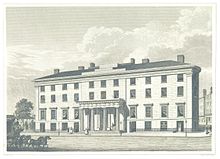Tremont House (Boston)


Tremont House (1829– c.1895), sometimes called the Tremont Hotel, was a hotel designed in 1829 by Isaiah Rogers in Boston, Massachusetts.[1] Notable guests included Davy Crockett[2] and Charles Dickens.[3]
The Tremont House was a four-story, granite-faced, neoclassical building, located at the corner of Tremont and Beacon Streets, with its main entrance on Tremont. It incorporated many hotel "firsts":
- Indoor plumbing
- Indoor toilets and baths
- Reception area
- Locked rooms for the guest
- Free soap
- Bellboys
Despite this long list of innovations, it is probably best known as the first hotel with indoor plumbing and running water. The hotel's water was raised by steam-powered pump to a storage tank on its roof, where it fed by gravity to the taps. Eight water closets (toilets) were provided on the ground floor. Bathrooms for bathing were located in the basement, and served by cold running water. Bathtubs were copper or tin, with local gas heating for the tub's water. Running water was also provided to the kitchen and laundry. A simple system removed the waste water to the sewage system.
The Tremont House set the standard for luxury accommodations and was the model for many hotels built in major cities at this time.[4] One of the most notable, also designed by Isaiah Rogers, was the Astor House (1836) in New York City.[5]
References
- ^ Tremont is always pronounced trem-mont in Boston, not tree-mont.
- ^ "Col. Davy Crockett arrived in this city on Monday, and put up at the Tremont House. He thinks Boston is the handsomest city he has seen. ... He has accepted an invitation to visit the Tremont theatre this evening. There was quite a crowd assembled in State-Street at noon yesterday to see the Colonel, but he was detained till a very late hour by the interesting performances at the Roxbury India rubber factory." cf. Boston Gazette, May 6, 1842
- ^ Benjamin F. Stevens. Tremont House: the exit of an old landmark. The Bostonian, v.1, no.4 1895.
- ^ Tremont House (Chicago)
- ^ Hotel: An American History by A. K. Sandoval-Strausz Edition: illustrated Published by Yale University Press, 2007 ISBN 0-300-10616-5, ISBN 978-0-300-10616-9 [1]
Images
-
Painting by James Bennett, c. 1830s
-
Tremont Street, 1860s; Tremont House at right, Park St. Church in distance
-
19th-century photo by John P. Soule
-
Room No.29, occupied by Charles Dickens and others.
-
Interior, 1894
-
Tremont House menu on June 21, 1857
Further reading
- Benjamin F. Stevens. Tremont House: the exit of an old landmark. The Bostonian, v.1, no.4 1895.
- Henry Lee. Boston's greatest hotel. Old-Time New England. Spring 1965.
- 1857 menu from the Tremont House - University of Houston Digital Library






